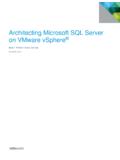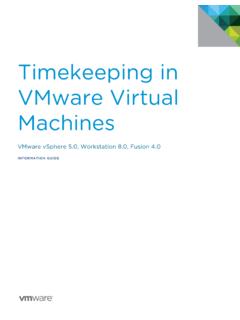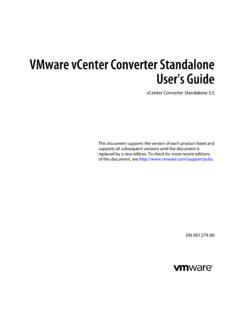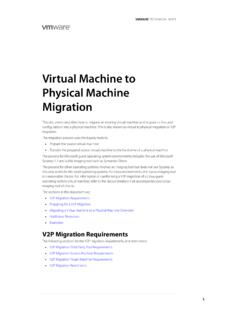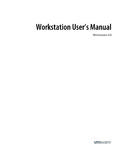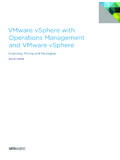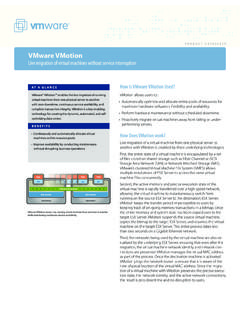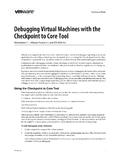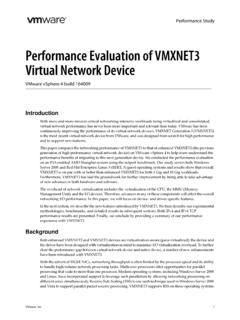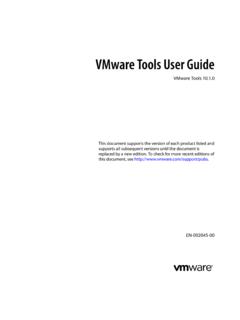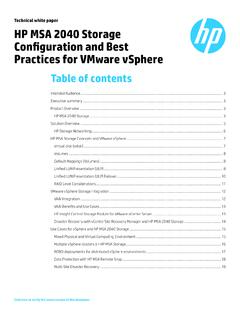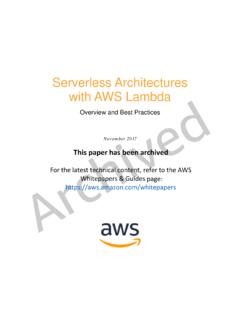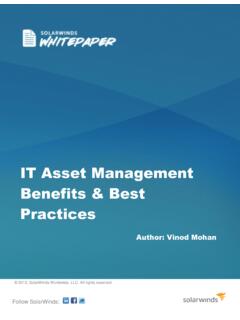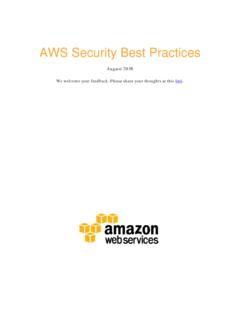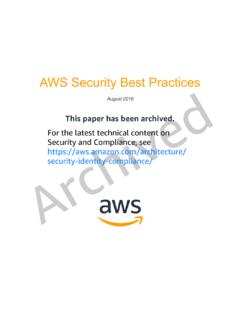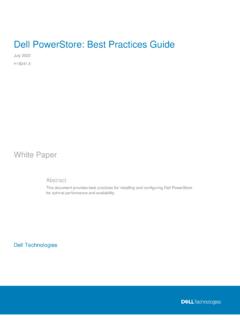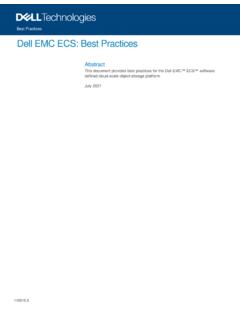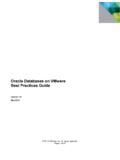Transcription of Performance Best Practices for VMware vSphere 7.0, Update 2
1 Performance best Practices for VMware vSphere , Update 2. VMware ESXi , Update 2. vCenter Server , Update 2. Performance best Practices for VMware vSphere , Update 2. You can find the most up-to-date technical documentation on the VMware Web site at: The VMware Web site also provides the latest product updates. If you have comments about this documentation, submit your feedback to: 2007-2015, 2017-2021 VMware , Inc. All rights reserved. This product is protected by and international copyright and intellectual property laws. VMware products are covered by one or more patents listed at VMware , the VMware boxes logo and design, Virtual SMP, and VMotion are registered trademarks or trademarks of VMware , Inc. in the United States and/or other jurisdictions. All other marks and names mentioned herein may be trademarks of their respective companies. Revision: 20210610. VMware , Inc. 3401 Hillview Ave. Palo Alto, CA 94304. 2 VMware , Inc. Contents About This Book 9. 1 Hardware for Use with VMware vSphere 11.
2 Validate Your Hardware 11. CPU Hardware Considerations 11. General CPU Considerations 11. Side-Channel Vulnerabilities 11. Hardware Mitigations 11. Microcode Mitigations 12. Software Mitigations 12. Hardware-Assisted Virtualization 12. Hardware-Assisted CPU Virtualization (VT-x and AMD-V ) 12. Hardware-Assisted MMU Virtualization (Intel EPT and AMD RVI) 12. Hardware-Assisted I/O MMU Virtualization (VT-d and AMD-Vi) 12. AES-NI Support 13. Memory Hardware Considerations 14. Persistent Memory (PMem) 14. Intel Optane Persistent Memory Modules 14. NVDIMM-N Persistent Memory 15. Storage Hardware Considerations 16. General Storage Hardware Considerations 16. Fibre Channel Considerations 17. VMware vStorage APIs for Array Integration (VAAI) 17. iSCSI and NFS Storage 18. NVMe Storage 18. NVMe over Fabrics (NVMe-oF) Storage 19. Network Hardware Considerations 20. Hardware BIOS Settings 21. General BIOS Settings 21. Processor-Specific BIOS Settings 21. Power Management BIOS Settings 22. 2 ESXi and Virtual Machines 23.
3 ESXi General Considerations 23. ESXi CPU Considerations 24. Side-Channel Vulnerability Mitigation in ESXi 25. Speculative Execution Vulnerabilities (aka Spectre, Meltdown, and Foreshadow) 25. Scheduler Options for L1 Terminal Fault (L1TF) Vulnerability Mitigation 25. Hyper-Threading 26. Non-Uniform Memory Access (NUMA) 27. Manual NUMA Configuration 27. Snoop Mode Selection 28. AMD EPYC Processor NUMA Settings 28. Persistent Memory (PMem) in NUMA Systems 29. Host Power Management in ESXi 29. Power Policy Options in ESXi 29. VMware , Inc. 3. Performance best Practices for VMware vSphere , Update 2. Confirming Availability of Power Management Technologies 30. Choosing a Power Policy 30. ESXi Memory Considerations 31. Memory Sizing 31. Memory Overcommit Techniques 31. Memory Page Sharing 32. Memory Swapping Optimizations 33. Memory Overhead 34. 2MB Large Memory Pages 35. Persistent Memory (PMem) 36. ESXi Storage Considerations 37. VMware vStorage APIs for Array Integration (VAAI) 37.
4 LUN Access Methods 37. Virtual Disk Modes 37. Virtual Disk Types 38. Automatic Space Reclamation (UNMAP) 39. Partition Alignment 39. SAN Multipathing 39. Storage I/O Resource Allocation 40. iSCSI and NFS Recommendations 41. NVMe Recommendations 41. NVMe-oF Recommendations 41. vSphere Virtual Machine Encryption Recommendations 42. General ESXi Storage Recommendations 42. Running Storage Latency Sensitive Workloads 43. ESXi Networking Considerations 44. General ESXi Networking Considerations 44. Network I/O Control (NetIOC) 44. Network I/O Control Configuration 44. Network I/O Control Advanced Performance Options 45. DirectPath I/O 45. Single Root I/O Virtualization (SR-IOV) 46. SplitRx Mode 46. Deactivating SplitRx Mode for an Entire ESXi Host 46. Activating or Deactivating SplitRx Mode for an Individual Virtual NIC 47. Receive Side Scaling (RSS) 47. Virtual Network Interrupt Coalescing 48. Running Network Latency Sensitive Workloads 49. Host-Wide Performance Tuning 50. 3 Guest Operating Systems 53.
5 Guest Operating System General Considerations 53. Microsoft Virtualization-Based Security (VBS) 54. Measuring Performance in Virtual Machines 54. Guest Operating System CPU Considerations 55. Side-Channel Vulnerability Mitigation in Guest Operating Systems 55. Virtual NUMA (vNUMA) 55. vNUMA and PMem 57. Guest Operating System Memory Considerations 58. Guest Operating System Storage Considerations 59. Guest Operating System Networking Considerations 60. Types of Virtual Network Adapters 60. Selecting Virtual Network Adapters 61. Virtual Network Adapter Features and Configuration 61. 4 VMware , Inc. Contents 4 Virtual Infrastructure Management 65. General Resource Management 65. VMware vCenter 66. VMware vCenter Database Considerations 67. VMware vCenter Database Network and Storage Considerations 67. VMware vCenter Database Configuration and Maintenance 67. PostgreSQL (vPostgres) Database Recommendations 68. VMware vSphere Management 69. vSphere Clients 69. vSphere Client Back-End Performance Considerations 69.
6 vSphere Client Front-End Performance Considerations 71. Tagging in vSphere 72. vSphere Web Services SDK Clients 72. VMware vMotion and Storage vMotion 73. VMware vMotion Recommendations 73. VMware Storage vMotion Recommendations 74. VMware Cross-Host Storage vMotion Recommendations 74. VMware Distributed Resource Scheduler (DRS) 76. DRS in General 76. DRS Cluster Configuration Settings 76. DRS Cluster Sizing and Resource Settings 78. DRS Performance Tuning 79. VMware Distributed Power Management (DPM) 81. DPM Configuration and Modes of Operation 81. Tuning the DPM Algorithm 81. Scheduling DPM and Running DPM Proactively 82. Using DPM With VMware High Availability (HA) 82. VMware vSphere Storage I/O Control 83. VMware Storage Distributed Resource Scheduler (Storage DRS) 84. VMware vSphere High Availability 85. VMware High Availability in General 85. Virtual Machine Component Protection (VMCP) 85. VMware Fault Tolerance 86. VMware vSphere Lifecycle Manager 88. Lifecycle Manager General Recommendations 88.
7 Lifecycle Manager Quick Boot Option 88. Lifecycle Manager Cluster Remediation 88. Lifecycle Manager Bandwidth Throttling 89. VMware vSAN 90. Hybrid versus All-Flash vSAN 90. vSAN Hardware Selection and Layout 90. Hardware Selection and Layout for Hybrid vSAN 90. Hardware Selection and Layout for All-Flash vSAN 90. Hardware Selection and Layout for vSAN in General 90. vSAN Network Considerations 90. vSAN Configuration and Use 91. vSAN Encryption 91. VMware vSphere Virtual Volumes (vVols) 92. vVols Hardware Considerations 92. vVols Workload Performance 92. vVols Management Operation Performance 92. vVols I/O Operation Performance 93. vVols Configuration Recommendations 93. VMware vCenter Single Sign-On Server 95. VMware , Inc. 5. Performance best Practices for VMware vSphere , Update 2. VMware vSphere Content Library 96. vSphere 7 with Kubernetes 97. 6 VMware , Inc. Tables Table 4-1. Advanced Configuration Options for the vSphere Client Back-End 71. Table 4-2. vCLS Agent Virtual Machine Specifications 78.
8 VMware , Inc. 7. Performance best Practices for VMware vSphere , Update 2. 8 VMware , Inc. About This Book This book, Performance best Practices for VMware vSphere Update 2, provides Performance tips that cover the most Performance -critical areas of VMware vSphere Update 2. It is not intended as a comprehensive guide for planning and configuring your deployments. This book consists of the following chapters: Chapter 1, Hardware for Use with VMware vSphere , on page 11, provides guidance on selecting hardware for use with vSphere . Chapter 2, ESXi and Virtual Machines, on page 23, provides guidance regarding VMware ESXi software and the virtual machines that run in it. Chapter 3, Guest Operating Systems, on page 53, provides guidance regarding the guest operating systems running in vSphere virtual machines. Chapter 4, Virtual Infrastructure Management, on page 65, provides guidance regarding infrastructure management best Practices . NOTE For planning purposes we recommend reading this entire book before beginning a deployment.
9 Material in the last chapter, Virtual Infrastructure Management, for example, might influence your hardware choices (covered in the first chapter, Hardware for Use with VMware vSphere ). Intended Audience This book is intended for system administrators who are planning a VMware vSphere Update 2. deployment and want to maximize its Performance . The book assumes the reader is already familiar with VMware vSphere concepts and terminology. Document Feedback VMware welcomes your suggestions for improving our documentation. If you have comments, send your feedback to: VMware vSphere Documentation The VMware vSphere documentation consists of the combined VMware vCenter and VMware ESXi documentation set. You can access the most current versions of the vSphere documentation by going to: You can access Performance and other technical papers on the VMware Technical Papers page: VMware , Inc. 9. Performance best Practices for VMware vSphere , Update 2. 10 VMware , Inc. 1. Hardware for Use with VMware vSphere 1.
10 This chapter provides guidance on selecting and configuring hardware for use with VMware vSphere . Validate Your Hardware Before deploying a system we recommend the following: Verify that all hardware in the system is on the hardware compatibility list for the specific version of VMware software you will be running. Make sure that your hardware meets the minimum configuration supported by the VMware software you will be running. Test system memory for 72 hours, checking for hardware errors. CPU Hardware Considerations This section provides guidance regarding CPUs for use with vSphere Update 2. General CPU Considerations When selecting hardware, it is a good idea to consider CPU compatibility for VMware vSphere . vMotion (which in turn affects DRS, DPM, and other features) and VMware Fault Tolerance. See VMware vMotion and Storage vMotion on page 73, VMware Distributed Resource Scheduler (DRS) . on page 76, and VMware Fault Tolerance on page 86. Side-Channel Vulnerabilities A class of security vulnerabilities collectively known as side-channel vulnerabilities have been discovered in many modern CPUs.
